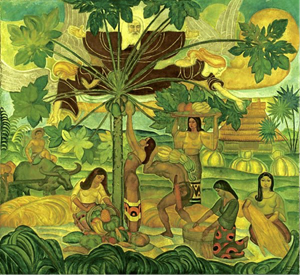
The history of Modern Philippine art is marked by the conflict between the rules and views of the Academy and the innovative methods of the Modernists. The Academic style was established during the Spanish colonial period and followed the rules of the Spanish, Italian and French Academies.
The history of Modern Philippine art is marked by the conflict between the rules and views of the Academy and the innovative methods of the Modernists. The Academic style was established during the Spanish colonial period and followed the rules of the Spanish, Italian and French Academies. When they first arrived in the Philippines in the early 16th century the Spaniards did so with the primary intention of spreading the Catholic faith. As a result religious art and the creation of icons were strongly encouraged. By late 19th century Neo-Classicism and Realism became the norm.
A turning point was the emergence of the “13 Modernists” group which included artists who had received their education abroad where they had come in contact with various new and experimental styles. They argued that the official art was too photographic and relied too much on the exactness of representation which led to rigidness and lack of originality. The Academy stroke back by framing the Modernists as charlatans who made shocking and controversial artworks to mask “their lack of skills”.
Below are five representative pieces of the 20th century art of the Philippines, a period which on social level saw the demise of the Spanish rule and the arrival of the Americans and on cultural level witnessed intense artistic exchanges with the West.
“Las Damas Romanas” by Juan Luna
“Las Damas Romanas”, painted by Juan Luna in the style of the Neo-Classicism, is one of the most famous paintings of the Colonial period. Skilled in the style of the Academy he was the first Filipino painter to win international recognition in Europe and the US.
“Houseboats in a River” by Fabian de la Rosa
The art of Fabian de la Rosa is considered to reflect the transition from Spanish rule to American occupation. Subdued landscapes and genre paintings with Impressionistic influence became the art of choice in the era of uncertainty and broken hopes.
“Planting Rice” by Fernando Amorsolo
The arrival of the Americans lead to a new wave of nationalism in Philippine society which is best reflected in the art of Fernando Amorsolo. The art of the period focused on traditional folk scenes as an embodiment of the imagined sense of nationhood. Traditional customs, pastimes and occupations are among the most recognisable motifs employed. In hindsight some historians have criticised Amorsolo for painting an idealised version of what life was like in those times while others have argued that his paintings reflected the people’s desire to escape from a complicated reality into simplicity.
“Interaction” by Victorio Edades
History names Victorio Edades as “the father” of Modern Philippine art. Schooled in the US upon his return he introduced an entirely new way of thinking about art. He argued that art can be more than representation of reality, it can be representation of reality as seen through the mind and emotions of the artist.
“The Musicians” by Vicente Manansala
One of the first Abstractionists on the Philippine art scene Vicente Manansala is also credited with bridging the gap between the city and the suburbs, between the rural and cosmopolitan ways of life. His paintings depict a nation in transition, an allusion to the new culture brought by the Americans. Manansala together with Fabian de la Rosa are among the best-selling Philippine artists in the West.

ArtDependence Magazine is an international magazine covering all spheres of contemporary art, as well as modern and classical art.
ArtDependence features the latest art news, highlighting interviews with today’s most influential artists, galleries, curators, collectors, fair directors and individuals at the axis of the arts.
The magazine also covers series of articles and reviews on critical art events, new publications and other foremost happenings in the art world.
If you would like to submit events or editorial content to ArtDependence Magazine, please feel free to reach the magazine via the contact page.